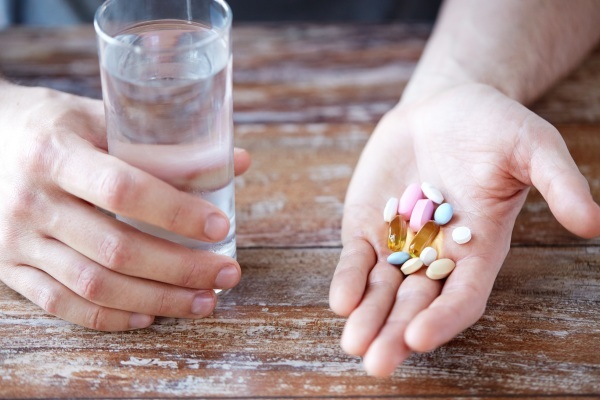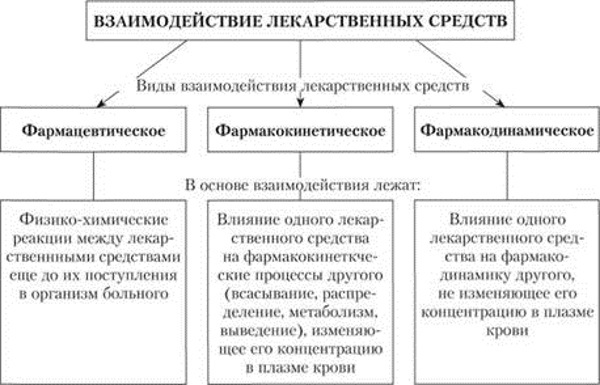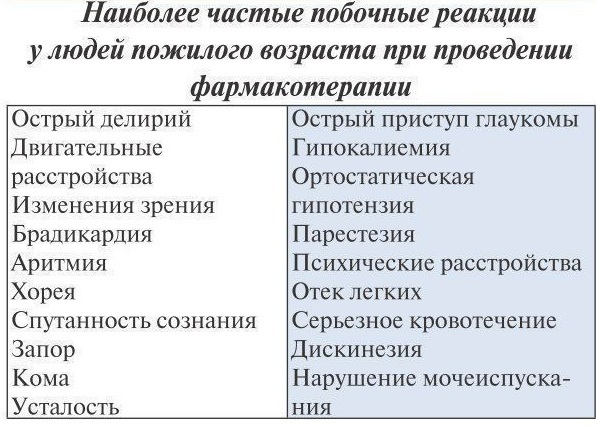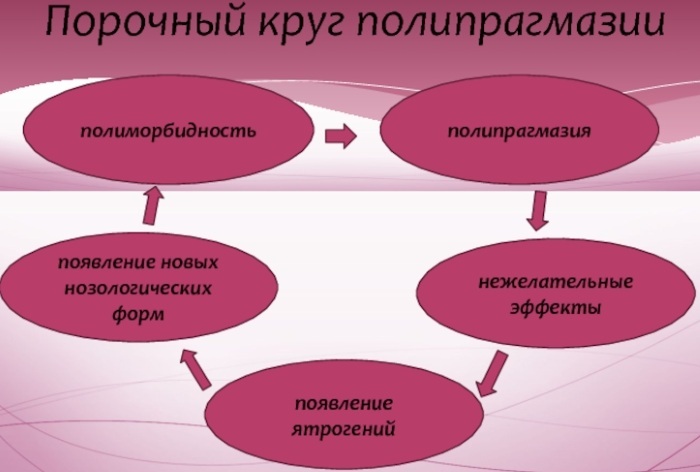Content
- Definition
- Possible reasons
- Age changes
- Unauthorized treatment
- Target organ damage
- Taking anticoagulants
- Therapy with hypoglycemic agents
- Improper glycoside treatment
- Taking antidepressants
- Simultaneous observation by several doctors at once
- Types of drug interactions
- Mixing several medicines
- Changing the concentration of the drug
- Increased risk of side effects
- Timely detection methods
- Possible consequences
- How to avoid
- Video about polypharmacy
Polypharmacy in the pharmaceutical industry represents a negative effect from exposure to a large number of drugs with different therapeutic properties. The development of polypharmacy is quite common in people suffering from severe diseases of the body, which require complex treatment with potent medications.
Definition
Polypharmacy in the field of pharmacology is a term that means the simultaneous administration of a large number of drugs with a strong therapeutic effect. Treatment with several drugs with similar properties leads to an increase in the biochemical properties of their main substances. In most cases, polypharmacy becomes the cause of drug overdose, as well as the manifestation of side effects of one or several medicines at once.
Patients of the following categories are at risk of polypharmacy:
- seriously ill;
- elderly people;
- children, adult men and women with acute and chronic diseases requiring intensive treatment;
- patients suffering from several pathologies of internal organs or life support systems of the body.
A professionally compiled course of therapy makes it possible to cure a serious illness, accelerate the body's recovery processes. At the same time, the risk of developing the polypharmacy effect caused by an incorrectly selected the dosage of medicines, the use of medicines with similar therapeutic properties and the action of the main components.
Polypharmacy can lead to adverse consequences in the form of hospitalization of a patient with signs of overdose and drug intoxication. Particularly severe cases end in death.
Possible reasons
Polypharmacy in pharmacology is a negative effect of the simultaneous administration of a large number of drugs with negative drug interactions. There are several main reasons, the presence of which can lead to the fact that the taken medications will not benefit, but harm the human body.
Age changes
Medical practice shows that the majority of patients with signs of polypharmacy are elderly people. Patients of this category often have several diseases of internal organs and life support systems at once, they are forced to take several types of potent drugs on an ongoing basis.
Age-related changes in the body, metabolic disorders, decreased functional activity internal organs leads to the fact that initially therapeutically safe doses of drugs become too high.
The active substances of several drugs at once are slowly excreted from the body, accumulate in the blood plasma and liver tissues. This leads to the appearance of negative symptoms of polypharmacy. In most cases, elderly patients are taken to the hospital of the toxicology department with signs of overdose and drug intoxication.
To avoid this effect, patients over 75 years old should be prescribed the minimum dose of drugs., which will allow for complex therapy of the underlying disease, but at the same time will not cause overdose and negative drug interactions.
Unauthorized treatment
Polypharmacy in pharmacology is the result of unauthorized treatment with several medicines at once. This effect is regularly encountered by people who, without visiting a specialized doctor, acquire over-the-counter drugs and then self-medication for one or more diseases.
In this case, the patient may not even guess that the simultaneous administration of specific medications is contraindicated, enhances the active components of the drugs or weakens their effect. Polypharmacy, which has arisen against the background of unauthorized use of drugs, develops due to the fact that it was not a professional calculation of the ratio of potential risk and benefit from the use of specific medicines.
Target organ damage
An equally common cause of polypharmacy is an underestimation of the functional state of the patient's liver and kidney tissues. In patients who have concomitant diseases of these organs, the physiological process of metabolic decomposition of the active substances of medicines is disrupted.
This leads to the fact that even small doses of drugs become toxic for the patient's body, which does not have time to carry out their excretion due to the reduced efficiency of the liver and kidneys. In this case, there is a real threat to the patient's life caused by increasing intoxication.
Taking anticoagulants
A large number of cases of polypharmacy are observed in patients who underwent complex therapy with several drugs with anticoagulant properties at once. Medicines in this category help to reduce the level of blood viscosity, thin it, preventing the formation of blood clots.
The effect of polypharmacy, which is caused by the simultaneous administration of a large number of drugs with anticoagulant properties, characterized by increased tissue bleeding, the risk of opening internal and external bleeding. This is especially true for patients who suffer not only from cardiovascular diseases, but also have ulcerative lesions of the stomach, erosion of the intestinal mucosa, inflammatory processes in the direct intestine.
Therapy with hypoglycemic agents
Regular intake of glucose-lowering drugs in the tablet form of release should be carried out on condition that the patient controls the level of glucose in the blood. Otherwise, against the background of a physiological decrease in metabolic processes, the development of the effect of polypharmacy is possible.
In such a situation, due to a violation of carbohydrate metabolism, even a small dose of drugs with hypoglycemic properties can cause hypoglycemia and a state of deep coma. If there are no people near the patient who can provide first aid, call doctors, then there is a high probability of death.
Improper glycoside treatment
Medicines from the pharmacological group of glycosides are potent drugs that target the organs of the cardiovascular system. These medicines are prescribed to patients with signs of functional insufficiency in the work of the heart.
An improperly formed course of glycoside therapy leads to the development of polypharmacy, which is expressed in severe heart rhythm disturbances. In medical practice, there are regular cases when drugs of this category cause cardiac arrest.
Taking antidepressants
Treatment with drugs from the group of antidepressants is dangerous because these drugs can cause polypharmacy. In this case, the opposite therapeutic effect develops.
A person with signs of polypharmacy from taking antidepressants is characterized by the following symptoms:
- complete indifference to events taking place in the surrounding world;
- development of disorders of the blood vessels of the brain;
- constant sleepiness;
- rapid progression of dementia;
- psycho-emotional depression.
Patients who are taking antidepressants must constantly monitor their psycho-emotional state in order to timely detect the onset of the polypharmacy effect.
Simultaneous observation by several doctors at once
Being treated by several doctors at once can also cause polypharmacy. For example, if doctors who deal with a patient's outpatient care do not interact with each other, do not exchange information regarding the prescription of drugs to the patient with potent properties. In this situation, it is very important that the patient notifies both doctors about which medications each specialist has prescribed for him.
Types of drug interactions
Negative drug interactions between drugs and their incorrect dosage regimen most often cause the development of a severe polypharmacy effect.
Mixing several medicines
This type of negative interaction of drugs is manifested due to the simultaneous mixing of several medicines, the active substances of which are incompatible in biochemical properties. For example, if the patient does not comply with the established schedule for taking medications prescribed by the attending physician.
In this case, the simultaneous use of two different drugs can enhance their pharmacological properties. The result of such therapy is the effect of polypharmacy, when a person immediately receives a double therapeutic dose that can cause various forms of overdose.
Changing the concentration of the drug
This type of negative drug interaction develops in clinical situations when the active ingredients of one drug affect the therapeutic properties of another drug.
For example, concomitant therapy with certain types of antibacterial agents and drugs to lower cholesterol levels can provoke the development of myopathy. To exclude this type of negative drug interaction, you need to monitor the concentration active substances that make up medicines, as well as take them according to the schedule drawn up doctor.
Increased risk of side effects
This type of negative drug interaction occurs if the patient has taken several drugs, one of which provokes the appearance of side effects of another drug. In pharmacology, this effect of polypharmacy is called a mutual increase in the potential risks of developing negative consequences.
A striking example of a negative interaction of this type is the simultaneous administration of drugs from the group of antiplatelet agents and anticoagulants. In this case, there is a reasonable risk of opening internal bleeding against the background of highly thinned blood and suppressed platelet function.
People who take several drugs at the same time need to remember that they interact with medications not only other medicines, but also biologically active additives, vitamin and mineral complexes, certain types of products nutrition. The table below describes examples of polypharmacy of various types.
| Other types of negative interactions | Characterization of the polypharmacy effect |
| Calcium preparations and carbonated drinks | Patients who drink calcium-based drugs with carbonated drinks run the risk of a lack of therapeutic effect. Carbonic acid neutralizes the properties of this mineral. |
| Tetracycline antibiotics and milk | Antibacterial drugs containing tetracycline should not be taken with milk. This product suppresses the therapeutic efficacy of the antibiotic. |
| Synthetic medicines and phytopreparations | Herbal medicines can exhibit properties of negative interaction with tablets and injectable medicines. For example, a decoction of St. John's wort neutralizes the therapeutic effect of taking oral contraceptives and antidepressants. |
| Sedatives and caffeine | The simultaneous use of sedatives with the use of foods and drinks containing caffeine creates the opposite therapeutic effect. The human nervous system does not calm down, but goes into a state of increased excitement. |
It has been clinically proven that the effect of polypharmacy can be caused even if immunosuppressants, anticancer, cardiovascular and hormonal drugs are washed down with natural grapefruit juice. In this case, the pharmacological properties of medicines in this category are enhanced by no less than 4 times.
Timely detection methods
Polypharmacy in pharmacology is a negative effect of the use of several drugs at once, the therapeutic doses of which caused a negative reaction in the body.
For the timely identification of these properties of medicines, the following methods are used:
- control over the general condition of the patient (for example, if the patient is being treated in an inpatient department of a medical institution);
- biochemical study of venous blood with the determination of clinical parameters that can be disturbed by the constituent components of drugs;
- hardware diagnostics of internal organs, when there are signs of dysfunctional disorders with sides of the tissues of the liver, kidneys, organs of the digestive and cardiovascular system (ultrasound, ECG, MRI, gastroscopy).
The sooner the effect of polypharmacy from the drugs taken is discovered, the less likely the development of complications and pathological changes in the work of internal organs, life support systems organism.
Possible consequences
The effect of polypharmacy can lead to the following negative consequences for human health:
- moderate or severe allergic reaction with signs of anaphylaxis;
- drug intoxication of the body;
- overdose with active ingredients of medicines;
- a disorder of the gastrointestinal tract, which is accompanied by nausea, loss of appetite, diarrhea, vomiting and attacks of pain inside the abdominal cavity;
- loss of consciousness;
- opening of internal bleeding;
- a decrease or a sharp increase in the level of blood pressure;
- the development of hypoglycemia with the further onset of a coma.
 The most harmless consequence of polypharmacy is the complete absence of a therapeutic effect from taking medication. For example, if one of the active substances of the drug has neutralized the effect of other chemical components. Otherwise, the development of the most severe side effects cannot be ruled out.
The most harmless consequence of polypharmacy is the complete absence of a therapeutic effect from taking medication. For example, if one of the active substances of the drug has neutralized the effect of other chemical components. Otherwise, the development of the most severe side effects cannot be ruled out.
How to avoid
To prevent the occurrence of polypharmacy from drugs, the following recommendations must be followed:
- undergo treatment with only one doctor, or notify doctors about visiting other doctors, so that they have comprehensive information about the properties of drugs that are prescribed by others specialists;
- observe the established dosage regimen with medicines;
- do not carry out the simultaneous administration of drugs, the active substances of which are incompatible;
- stop further medication therapy in case of signs of an allergic reaction, or a sharp deterioration in general health;
- always remember that the effect of polypharmacy can be provoked not only by drugs, but also by certain types of drinks and food consumed simultaneously with drugs.
Polypharmacy in the field of pharmacology is the result of a negative interaction of the chemical components of drugs that are taken by a patient over a certain period of time. The manifestation of this effect is accompanied by an increase in the side properties of medicines, the appearance of signs of an overdose.
The causes of polypharmacy are associated with a violation of the established regimen for taking medications, carrying out simultaneous therapy with medicines that cannot be combined due to negative consequences for the body the patient. Elderly people with a large number of chronic diseases are at an increased risk of polypharmacy.
Video about polypharmacy
What is polypharmacy:



